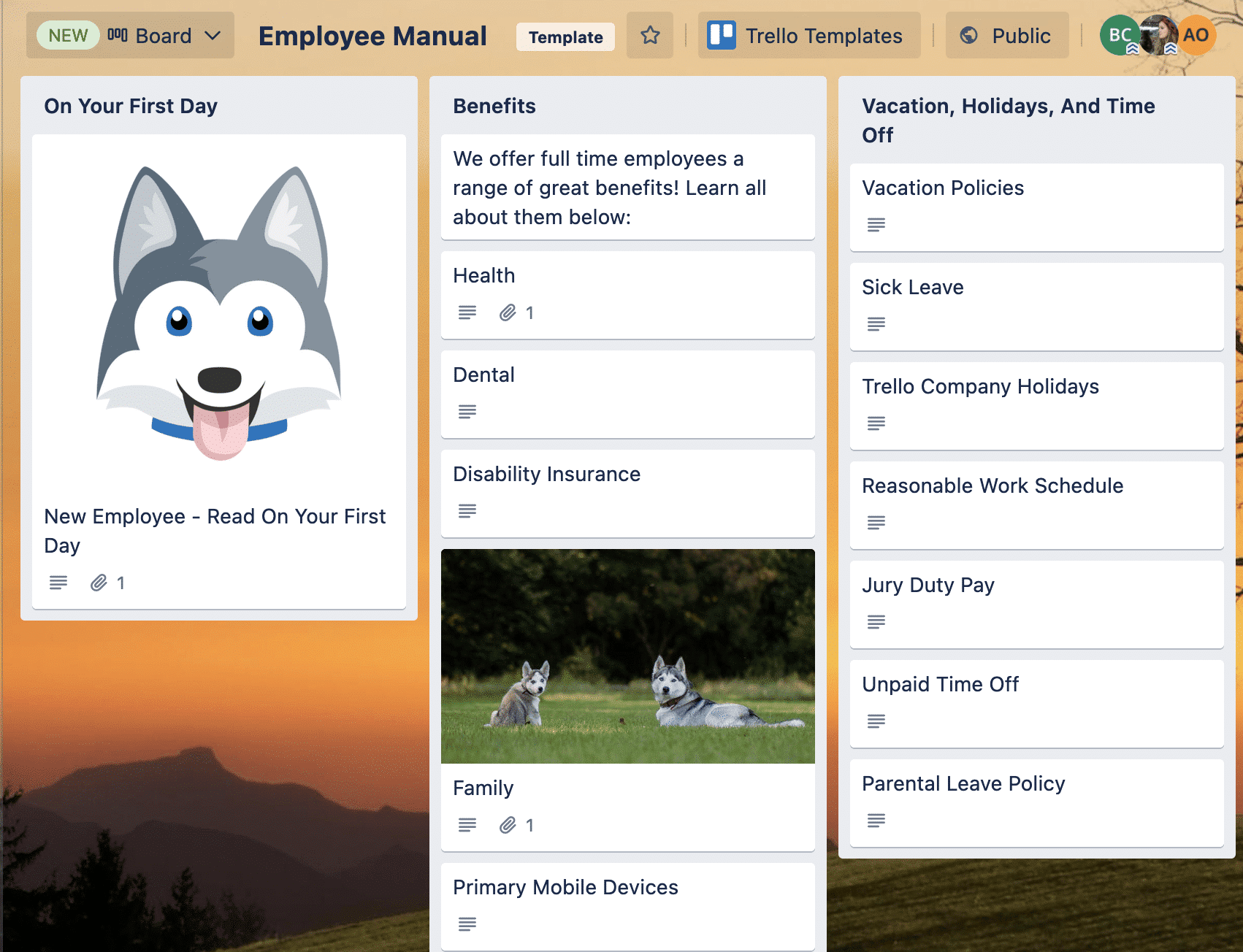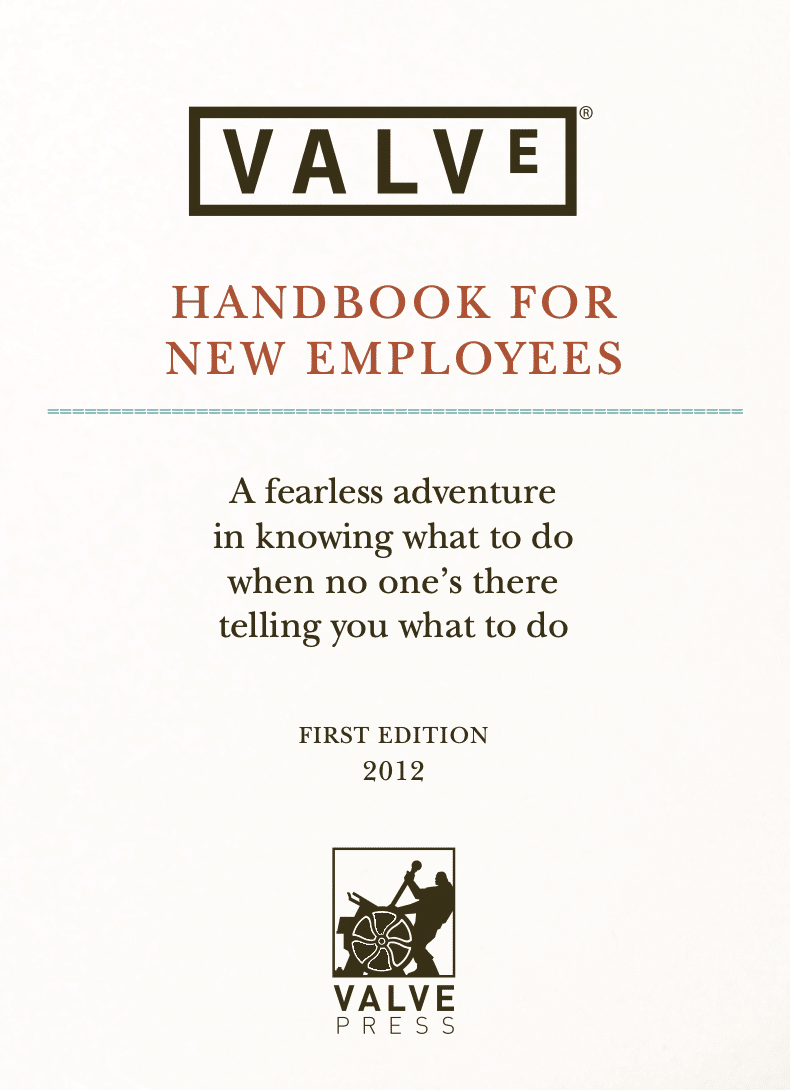Starting out at a new company can be an overwhelming experience for employees. A well-crafted employee handbook can eliminate a lot of the uncertainty and confusion new hires experience at their new position.
You want your new hires to succeed as much as they themselves do. But starting at a new company is a big task that involves lots of learning in a short period of time.
An employee handbook can eliminate the guesswork when new employees start at your business. Instead of a trial-and-error learning process, your company’s handbook maps out everything new hires will need to know to be successful.
We’ll walk you through everything you need to know to create an effective and engaging employee handbook and show you some of our favourite employee handbook examples.
What is an Employee Handbook?
An employee handbook is a document that outlines your business goals, company culture, expectations for new employees, and other important information for new hires.
These handbooks can vary in length and detail, depending on how in-depth your employee orientation is. Some can be over 50 pages long, others only 5 pages long. An effective handbook should be detailed, but also concise, and scannable.
What is the Purpose of Having an Employee Handbook?
Your employee handbook plays an important role in acclimatizing new hires to their responsibilities and expectations. Rather than having to explain all this information to new employees, your handbook lets employees learn about their new position and company at their own pace.
Ultimately, your handbook is meant to get your employees comfortable with their new position. Anxiety can be paralyzing for employees, but the information contained within your handbook should answer many if not all of the questions new hires may have.
Get better workplace engagement insights with these survey questions for employees.
Why is an employee handbook important?
An employee handbook provides a consistent in-person and digital employee experience for all your new hires. Employees will engage with your business in different ways, but they’ll all have the same introduction to your business’ culture and structure via your handbook.
These handbooks help establish your company culture to new hires while reducing the need for lengthy orientations. New employees should understand what is expected of them and how they can contribute to your business after consulting their handbook.
What are the benefits of an employee handbook?
There are numerous benefits for creating a handbook for your new employees. With a well-crafted handbook you can:
- Save time on your employee orientation and onboarding.
- Help new employees learn about the organization at their own pace.
- Inform employees about your business’ company culture, objectives, and expectations.
- Ensure new hires know where to direct their questions.
Your handbook should supplement your existing onboarding resources to make new employees’ as comfortable as possible with their new role.
Giving new hires a resource they can consult at their leisure can imbue them with that much-needed autonomy so important when establishing oneself at a new organization.
What Should Be Included in an Employee Handbook?
Your handbook should include everything new employees need to succeed at your company. This can range from practical instructions—like how to acquire a company email—to descriptions of your company’s values and goals—like your mission statement or employee code of conduct.
If you’re looking for ideas for your employee handbook, you can conduct employee surveys to see what your newer employees would’ve liked to know. Create survey questions using ContactMonkey’s OpenAI ChatGPT integration by providing a prompt describing what kind of information you’d like to collect.
Here are some ideas for what you can include in your handbook:
1. Mission statement or list of objectives
The layout of your employee handbook content is pretty flexible; you can vary what you mention, where you mention it, and how you mention it. But we highly suggest beginning your employee handbook with your business’ mission statement or list of objectives.
A mission statement states why your business exists and what it was created to accomplish. It also describes how you intend to accomplish these goals, and this is where readers first get an idea of the values important to your business.
Your company values will contextualize the rest of the information in your employee handbook, which is why we suggest highlighting them right off the bat. It tells readers what kind of company you are—from the material aspects like what you produce and how you produce it, to the impact you want your company to have in its industry and community.
2. Company culture statement or description
Think of your company culture statement is like a more in-depth description of your mission statement, only it focuses specifically on your company’s values, beliefs, and treatment of employees. Both your mission statement and your company culture statement help new employees align their values with those of your company.
William Kahn’s idea of cognitive engagement relates heavily to your company culture and how your employees relate to it. For your employees to care about their work, they need to feel as though as their personal values align with those of the business. By stating them in your employee handbook, your employees will have an easier time identifying their own values with your company values.
3. Organization structure or list of different departments
Moving on from company values and goals, it’s time to start providing practical information to the readers of your employee handbook. An organizational structure diagram or chart can quickly clear up questions that your new hires will surely have.
A organizational map of your business will let new employees who does what, to whom they can ask questions, their direct colleagues, and more. Don’t be afraid to get creative with this chart; try adding pictures of the individuals at your organization, or get them to contribute quotes or advice—if this format fits your company culture of course.
For larger companies, consider creating department-specific organizational charts, so new employees will learn what’s directly applicable to them. And of course, if a particular section has a large number of employees, consider using references instead of listing each name individually. Include a reference list elsewhere in the handbook where you can plug in abbreviations into your chart. This will save space and can be used in other places within your employee handbook.
4. Code of conduct to outline behaviour expectations for new hires
Time to get into the details of your company culture. You’ve probably already outlined your company’s overall values within your company culture statement. Your business’ code of conduct describes how those values should be materialized via your employees’ conduct.
Your code of conduct describes acceptable behaviour for everyone at your business. This behaviour can be between employees, employees and employer, or employees and customers or clients. Codes of conduct help make sure everyone is on the same page as to how your business ought to operate. It should clear up questions new employees may have and provide easy-to-understand rules and guidelines regarding behaviour, language, tact, and everything in between.
5. Payroll, benefits, and other administrative necessities
Another useful component of your employee handbook is an administrative necessities section. Here you can describe the payroll structure of your business, as well as professional benefits like healthcare coverage, vacation and sick days, maternity and paternity leave, and more.
This section serves two benefits for your new and current employees. Not only can this information can be easily referenced whenever it’s needed, but it also serves to highlight how employees are valued to new hires.
6. Safety policies and procedures
Another important piece of information for employees new and current are your safety policies and procedures. Businesses in all industries are tasked with keeping their employees safe, and how they do that is always evolving. The safety section of your employee policy should outline the critical parts of your safety protocols, and allude to more detailed resources for employees to consult.
Not sure how your employees feel about your business’ safety efforts? Try conducting an employee safety survey at your company to gauge what safety measures are working and which aren’t. You’ll likely come away from the survey with several new ideas for ensuring that your employees remain healthy and happy.
7. Social media policies
Depending on your type of business, this can be included within the code of conduct section of your employee handbook. But for companies that rely heavily on social media or require employees to be active on social media, outlining these policies in their own section is likely preferable.
This section—like your code of conduct—outlines acceptable practices, language, tact, and other considerations for employees using social media. It can include what hashtags your employees should use, how to format their social media posts across different platforms, how to curate their timelines, and other things of that nature. Your social media policies should help ensure that those representing your business in public spaces like social media do so in a way that accords with your company’s mission statement and values.
8. Professional development opportunities
Think of this section kind of like your organizational chart combined with your benefits section. If your business offers ample opportunities for employees to get promoted, let them know!
This will help employees get a further understanding of how your company is structured. It will also present them with realistic goals for their career at your business, which can motivate their work efforts.
Not every handbook will follow the same formula. Collect employee feedback from your existing staff and ask what best prepared them to succeed at your business.
Use your internal communications to collect employee feedback. With ContactMonkey’s employee feedback software, you can collect employee feedback and anonymous comments using your employee emails.
Remember, your handbook can act as a reference guide for your new hires. Think of information that they’ll need to refer to repeatedly when starting at your company.
Step up two-way communication across your company with our employee feedback examples.
What Should Not Be Included in an Employee Handbook?
Avoid including information that is subject to frequent change. This will save you from constantly having to update your handbooks.
Consider describing your organization’s hierarchy. While it’s best for new hires to understand who they are reporting to, you need not include the actual names of managers, CEOs, and alike. Rather, just include the position title and where they fall in the hierarchy.
You should also omit any information that isn’t directly relevant for new employees. Workers are confronted with a mountain of information when starting a new job, so avoid overloading them at all costs.
How to Create an Employee Handbook
Like any guide, it’s important to map out the content for your handbook beforehand. Create a list of everything you’d like to feature in your handbook, including how many pages it may take up and if it requires any images or other content.
Organize your handbook content into a coherent, easy-to-follow format. This can take different configurations depending on your preferences:
Section-based format
This is the way most people think to structure their guides or handbooks. Information is presented by topic, generally getting more specific as the reader progresses further and gains more knowledge.
Section-based organization is good for quickly referencing individual topics and sections. Employees can quickly skip to relevant sections using a table of contents, and refer to information when they need it.
Timeline-based format
You can also organize your handbook content in a timeline-based format. Rather than sections based on different topics, your handbook presents information based on new hires’ progression at your company.
For example, a timeline-based format could be divided into different sections such as:
- First day
- First week
- First month
- 3 months and on…
Presenting information in this way can help new employees plan ahead and manage their time at your company better when first starting. This is also a more functional way of structuring your handbook, as it gives new hires a better idea of when to apply your handbook’s information.
Best Employee Handbook Examples
Creativity is your best friend when creating your handbook. Check out these amazing employee handbook examples to inspire your own employee engagement ideas:
Trello
Trello uses their own software to create a unique employee handbook for their employees:

Employees can read orientation materials while simultaneously learning how Trello’s task management software works. This is an effective way to educate employees and show off the versatility of your product.
Valve
A well-known example of creative employee handbook design is Valve’s handbook for new employees.
Valve uses a game-inspired theme for their handbook, which helps communicate their company culture to new employees. They also organize their handbook in a unique way:

Rather than a bunch of semi-related categories, Valve organizes their handbook based on a new employee’s experience. This is a great example of a timeline-based handbook.
Hubspot
Hubspot also takes a unique approach to employee onboarding. The Hubspot Culture Code is presented to new employees via slideshow.
This streamlined approach reflects the attitude of the culture code itself: simple is better. Their culture code is very informal, and states in plain language what Hubspot expect of its employees:

Like other alternatives to Hubspot, Hubspot designed its handbook to reflect its company culture. Consider how your onboarding process communicates what’s important to your business to new hires.
Employee handbook templates
It’s helpful to create a template of your handbook after you’ve created it. Templates allow you to easily update your handbook without having to make substantial changes to its format.
You can also find numerous free employee handbook templates on the internet, but we recommend designing your own so it best represents your company culture.
How to Update Your Employee Handbook
You should update your handbook as your organization and work culture change. After all, the whole point of the guide is to familiarize new employees with your company; the last thing you want is to mislead them.
Pay attention to policy changes, new positions, new departments, company initiatives, or any information that is referenced in your employee handbook. In addition to frequent monitoring, set a schedule for when you should review your handbook. This way you can ensure your employee onboarding always stays up to date.
How to create a digital employee handbook
Your handbook can be in both physical and electronic formats. Ideally, you should use a design program like InDesign to create your handbook. You’ll be able to create a shareable PDF version of your handbook while being able to print out a physical copy as well.
How to Distribute Your Employee Handbook
Issue your handbook to newly hired employees as soon as possible. Afford new hires the greatest amount of time possible to review their handbook. Questions that employees have about starting their new position can be often answered by the handbook.
Depending on whether you issue physical or electronic copies of your handbook, you can present your handbook in different ways. If you send an electronic handbook, you can send sections of your handbook for new hires to review. You can collect a digital signature from your new hires when they’ve completed reading the section of the handbook.
Easily share your handbook with new hires using an onboarding template. Create a new employee introduction email that includes a link to your handbook so your employees will be prepared from day one.
If only some of your employees require your employee handbook, consider using ContactMonkey’s List Management feature to create custom email lists. Your custom email lists can be created without IT and integrate with your Human Resource Information System (HRIS) like Workday and ADP, as well as Azure Active Directory, so they’ll update automatically.
Start Using an Employee Handbook Today
An effective employee onboarding process contributes to positive work culture and reduces employee turnover. Your employee handbook is an integral part of your onboarding strategy and an initial way to measure employee engagement.
Familiarize new employees with their roles and responsibilities, alleviate possible anxieties, and provide an important reference for your new hires with a well-crafted employee handbook.
Looking for a proven way to increase employee engagement? ContactMonkey’s internal communications software helps connect your employees to their workplace and each other. Learn more by booking a free demo: